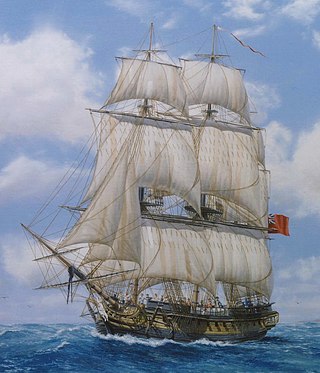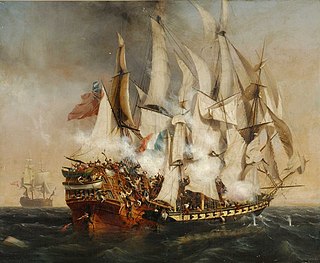Related Research Articles

Pomone was a 40-gun frigate of the French Navy, launched in 1785. The British captured her off the Île de Batz in April 1794 and incorporated her into the Royal Navy. Pomone subsequently had a relatively brief but active career in the British Navy off the Atlantic and Mediterranean coasts of France before suffering sufficient damage from hitting a rock. Due to this, the ship was taken out of service and then broken up in 1803.

HMS Melampus was a Royal Navy fifth-rate frigate that served during the French Revolutionary and Napoleonic Wars. She captured numerous prizes before the British sold her to the Royal Netherlands Navy in 1815. With the Dutch, she participated in a major action at Algiers and, then, in a number of colonial punitive expeditions in the Dutch East Indies.

HMS Amethyst was a Royal Navy 36-gun Penelope-class fifth-rate frigate, launched in 1799 at Deptford. Amethyst served in the French Revolutionary Wars and the Napoleonic Wars, capturing several prizes. She also participated in two boat actions and two ship actions that won her crew clasps to the Naval General Service Medal. She was broken up in 1811 after suffering severe damage in a storm.
His Majesty's hired armed cutter Courier appears twice in the records of the British Royal Navy. The size and armament suggests that both contracts could represent the same vessel, but other information indicates that the second Courier had been captured from the French in the West Indies. On the first contract the captain and crew were awarded clasps to the Naval General Service Medal, one for a boat action and one for a single ship action in which they distinguished themselves.

During the eighteenth and nineteenth centuries the Royal Navy made use of a considerable number of hired armed vessels. These were generally smaller vessels, often cutters and luggers, that the Navy used for duties ranging from carrying despatches and passengers to convoy escort, particularly in British coastal waters, and reconnaissance.
During the French Revolutionary and Napoleonic Wars, British vessels captured at least 12 French warships and privateers named Espoir, which means “Hope” in French. In only one case was there mention of an exchange of fire or casualties. In general, the privateers tried to escape, and failing that surrendered.

HMS Greyhound was a cutter that the British Admiralty purchased in 1780 and renamed Viper in 1781. Viper captured several French privateers in the waters around Great Britain, and took part in a notable engagement. She was sold in October 1809.
The French lugger Affronteur was launched in 1795 and in 1796-7 participated in the Expédition d'Irlande. In 1803, HMS Doris captured her and she subsequently served the Royal Navy either as a commissioned vessel or, more probably, as His Majesty's hired armed brig Caroline. In 1807 she was either broken up, or became a letter of marque.
At least two vessels known as His Majesty's hired armed lugger Nile served the Royal Navy during the French Revolutionary and Napoleonic Wars. These may have been the same vessel on sequential contracts.
HMS Barbara was an Adonis class schooner of the Royal Navy and launched in 1806. A French privateer captured her in 1807 and she became the French privateer Pératy. The Royal Navy recaptured her in 1808. She was paid off in June 1814 and sold in February 1815.
Since the 1760s, there have been numerous vessels named Royal Charlotte, for Charlotte of Mecklenburg-Strelitz, consort of King George III.
HMS Canso was the American letter of marque schooner Lottery, launched in 1811, that a British squadron captured in 1813. The Royal Navy took Lottery into service as HMS Canso and she served during the War of 1812 and briefly thereafter. The navy sold her in 1816.
His Majesty's hired armed schooner Lady Charlotte served the British Royal Navy on contract between 28 October 1799 and 28 October 1801. She had a burthen of 120 85⁄94 tons (bm), and was armed with twelve 12-pounder carronades. As a hired armed vessel she captured several privateers and recaptured a number of British merchant vessels. After her service with the Royal Navy, she apparently sailed as a letter of marque until the French captured her in 1806.

Confiance, launched in 1797, was a privateer corvette from Bordeaux, famous for being Robert Surcouf's ship during the capture of the British East India Company's East Indiaman Kent. The British Royal Navy captured Confiance in 1805, took her into service under her existing name, and sold her in 1810. Before she was sold, Confiance took part in two notable actions.

HMS Swallow was an 18-gun Albatross-class brig-sloop of the British Royal Navy, launched in 1795 and sold in 1802. During her naval career she captured a number of French privateers while on the Jamaica station. After her sale she became an armed whaler sailing under a letter of marque. As a privateer she captured two French whaling vessels but then is no longer listed after 1810.
The French brig Duc de Chartres was built between 1779 and 1780 at Le Havre as a 24-gun privateer. As a privateer she captured one British warship before in 1781 the Royal Navy captured her. The Royal Navy took her into service as HMS Duc de Chartres. She then captured several American privateers and armed merchant vessels, and one French naval corvette in a noteworthy single-ship action. The Navy sold Duc de Chartres in 1784.
Sorcière was the name of several privateers that sailed during the Napoleonic Wars. Three were French vessels, but one was British, though the British Sorciere was probably the Sorcière launched in 1803 at Saint-Malo that the British Royal Navy captured in April 1806.

HMS Narcissus was the lead ship of the Royal Navy Narcissus-class 32-gun fifth-rate frigates, launched in 1801. She participated in the War of 1812.
The Royal Navy purchased HMS Barracouta on the stocks in 1782. After she had served for almost ten years patrolling against smugglers, the Navy sold her in 1792. She became the privateer Thought, which had a successful cruize, capturing several prizes including a French privateer, but then was herself captured in September 1793. She served the French Navy under the names Pensée, Montagne, Pensée, and Vedette, until the British recaptured her in 1800 and renamed her HMS Vidette. The Royal Navy sold her in 1802.
References
- Colledge, J. J.; Warlow, Ben (2006) [1969]. Ships of the Royal Navy: The Complete Record of all Fighting Ships of the Royal Navy (Rev. ed.). London: Chatham Publishing. ISBN 978-1-86176-281-8.
- Commons, House of, Great Britain (1802) History of the proceedings and debates of the House of Commons. (Printed for J. Almon).
- Grant, James (1880) Cassell's old and new Edinburgh.
- Mahan, Alfred Thayer (1898) Major Operations of the Royal Navy, 1762-1783: Being Chapter XXXI. in The Royal Navy. A History. (Little, Brown).
- Malcomson, Robert (2001) Warships of the Great Lakes 1754-1834. (Annapolis: Naval Institute Press). ISBN 9781557509109
- Marx, robert F. (1987) Shipwrecks in the Americas. (Courier Dover Publications). ISBN 978-0486255149
- Norie, J. W. (1842) The naval gazetteer, biographer and chronologist; containing a history of the late wars from ... 1793 to ... 1801; and from ... 1803 to 1815, and continued, as to the biographical part to the present time. (London, C. Wilson).
- Smith, Graham (1983) King's cutters: the Revenue Service and the war against smuggling. (Conway Maritime Press). ISBN 0851772919